| Giovanni Paolo Panini | |
|---|---|
 Portrait of Panini by Louis Gabriel Blanchet Portrait of Panini by Louis Gabriel Blanchet | |
| Born | (1691-06-17)17 June 1691 Piacenza, Duchy of Parma, Holy Roman Empire |
| Died | 21 October 1765(1765-10-21) (aged 74) Rome, Papal States (now Italy) |
| Nationality | Italian |
| Other names | Gian Paolo Panini/Pannini |
| Movement | Baroque |
Giovanni Paolo, also known as Gian Paolo Panini or Pannini (17 June 1691 – 21 October 1765), was an Italian Baroque painter and architect who worked in Rome and is primarily known as one of the vedutisti ("view painters"). As a painter, Panini is best known for his vistas of Rome, in which he took a particular interest in the city's antiquities. Among his most famous works are his view of the interior of the Pantheon (on behalf of Francesco Algarotti), and his vedute—paintings of picture galleries containing views of Rome. Most of his works, especially those of ruins, have a fanciful and unreal embellishment characteristic of capriccio themes. In this they resemble the capricci of Marco Ricci. Panini also painted portraits, including one of Pope Benedict XIV.
Biography
As a young man, Panini trained in his native town of Piacenza, under Giuseppe Natali and Andrea Galluzzi, and with stage designer Francesco Galli-Bibiena. In 1711, he moved to Rome, where he studied drawing with Benedetto Luti.
In 1724 he married Miss Gossert, sister-in-law of Wengkels, director of the French Academy in Rome, with whom he had two sons: Giuseppe Pannini (Rome, 1720-1812), the architect, and Francesco Panini (Rome, 1745 - 1812), the painter, who followed in his father's footsteps and manners.
In Rome, Panini earned a name for himself as a decorator of palaces. Some of his works included the Villa Patrizi (1719–1725), the Palazzo de Carolis (1720), and the Seminario Romano (1721–1722). In 1719, Panini was admitted to the Congregazione dei Virtuosi al Pantheon. He taught in Rome at the Accademia di San Luca and the Académie de France, where he is said to have influenced Jean-Honoré Fragonard. In 1754, he served as the prince (director) of the Accademia di San Luca.
The Spanish monarchs appreciated his work in such a way that, commissioned by Filippo Juvarra, he sent paintings to decorate the Lacquer Room of the Royal Palace of La Granja de San Ildefonso. In addition, King Carlos IV, when he was Prince, bought several of his works that are still preserved in the Prado Museum and in the royal palaces.
Panini died in Rome on 21 October 1765.
Legacy
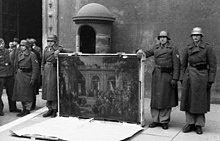
Panini's studio included Hubert Robert and his son Francesco Panini. His style influenced other vedutisti, such as his pupils Antonio Joli and Charles-Louis Clérisseau, as well as Canaletto and Bernardo Bellotto, who sought to meet the need of visitors for painted "postcards" depicting the Italian environs. Some British landscape painters, such as Marlow, Skelton and Wright of Derby, also imitated his capricci.
In addition to being a painter and architect, Panini was a professor of perspective and optics at the French Academy of Rome. His masterful use of perspective was later the inspiration for the creation of the "Panini Projection", which is instrumental in rendering panoramic views.
Panini's works are held in the permanent collections of many museums worldwide, including the Prado Museum, the Louvre, the Museo Nazionale di Capodimonte, the Museo Thyssen-Bornemisza, the Hermitage, the Pushkin Museum, the Staatsgalerie Stuttgart, the Staatliche Museen, the Palazzo del Quirinale, the Toledo Museum of Art, the University of Michigan Museum of Art, the Brooklyn Museum, the Saint Louis Art Museum, the Detroit Institute of Arts, the Museum of Fine Arts Boston, the Getty Center, the Metropolitan Museum of Art, the Nelson-Atkins Museum of Art, the Virginia Museum of Fine Arts, the Walters Art Museum, the Harvard Art Museums, the Philadelphia Museum of Art, and the Indianapolis Museum of Art.
Gallery
History paintings
-
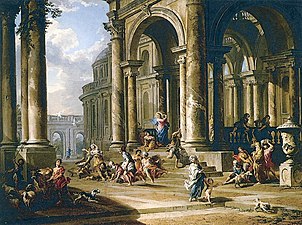 Expulsion of the Moneychangers from the Temple (c. 1724), oil on canvas, 74 x 99 cm., Thyssen-Bornemisza Museum
Expulsion of the Moneychangers from the Temple (c. 1724), oil on canvas, 74 x 99 cm., Thyssen-Bornemisza Museum
-
 The Wedding at Cana (c. 1725), oil on canvas, 99.2 × 137.2 cm., Speed Art Museum
The Wedding at Cana (c. 1725), oil on canvas, 99.2 × 137.2 cm., Speed Art Museum
-
 Marcus Curtius Leaping into the Gulf (no date), oil on canvas, 73.7 x 98.1 cm., Fitzwilliam Museum
Marcus Curtius Leaping into the Gulf (no date), oil on canvas, 73.7 x 98.1 cm., Fitzwilliam Museum
-
 Apollo and Mars (no date), oil on canvas, Diocesan Museum of Milan
Apollo and Mars (no date), oil on canvas, Diocesan Museum of Milan
Capriccios
-
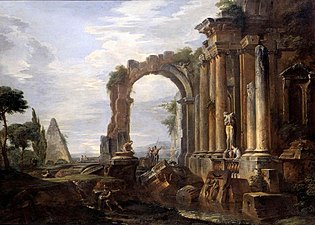 Capriccio of Classical Ruins (c. 1725-30), oil on canvas, 123 x 132 cm., private collection
Capriccio of Classical Ruins (c. 1725-30), oil on canvas, 123 x 132 cm., private collection
-
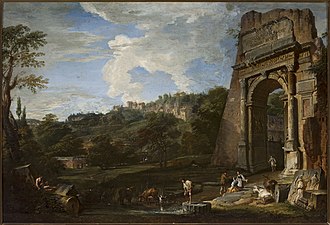 Landscape with the Arch of Titus (1725-50), oil on canvas, 51 x 76 cm., National Museum, Warsaw
Landscape with the Arch of Titus (1725-50), oil on canvas, 51 x 76 cm., National Museum, Warsaw
-
 Roman Capriccio: The Colosseum and Other Monuments (1735), oil on canvas, 98.4 x 133 cm., Indianapolis Museum of Art
Roman Capriccio: The Colosseum and Other Monuments (1735), oil on canvas, 98.4 x 133 cm., Indianapolis Museum of Art
-
 A Capriccio of Roman Ruins (1737), oil on canvas, 36.8 x 69.2 cm., Fitzwilliam Museum
A Capriccio of Roman Ruins (1737), oil on canvas, 36.8 x 69.2 cm., Fitzwilliam Museum
-
 Fantasy View with the Pantheon and other Monuments of Ancient Rome (1737), oil on canvas, 99 x 137.5 cm., Museum of Fine Arts, Houston
Fantasy View with the Pantheon and other Monuments of Ancient Rome (1737), oil on canvas, 99 x 137.5 cm., Museum of Fine Arts, Houston
-
 St Sibyl's Sermon in Roman Ruins with the Statue of Apollo (1740s), oil on canvas, 81 x 125 cm., Hermitage Museum
St Sibyl's Sermon in Roman Ruins with the Statue of Apollo (1740s), oil on canvas, 81 x 125 cm., Hermitage Museum
-
 A Capriccio of the Roman Forum (1741), oil on canvas, 170.8 x 217.8 cm., Yale University Art Gallery
A Capriccio of the Roman Forum (1741), oil on canvas, 170.8 x 217.8 cm., Yale University Art Gallery
-
 Architectural Capriccio of the Roman Forum with Philosophers and Soldiers (1745-50), oil on canvas, 98.4 x 135 cm., National Museum of Western Art
Architectural Capriccio of the Roman Forum with Philosophers and Soldiers (1745-50), oil on canvas, 98.4 x 135 cm., National Museum of Western Art
Veduta (contemporary Rome)
-
 Piazza Navona in Rome (1729), oil on canvas, 107 x 248 cm., Louvre
Piazza Navona in Rome (1729), oil on canvas, 107 x 248 cm., Louvre
-
 The Nave of St. Peter's Basilica in the Vatican (1735), oil on canvas, 153 x 219.7 cm., Norton Simon Museum
The Nave of St. Peter's Basilica in the Vatican (1735), oil on canvas, 153 x 219.7 cm., Norton Simon Museum
-
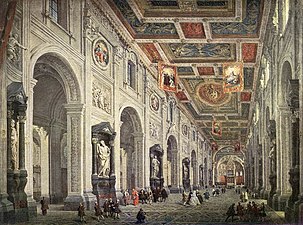 Interior of the San Giovanni in Laterano in Rome (no date), oil on canvas, 74 x 100 cm., Pushkin State Museum of Fine Arts
Interior of the San Giovanni in Laterano in Rome (no date), oil on canvas, 74 x 100 cm., Pushkin State Museum of Fine Arts
-
 Lotteria in Piazza di Montecitorio (1743), oil on canvas, National Gallery
Lotteria in Piazza di Montecitorio (1743), oil on canvas, National Gallery
-
 The delivery of the Order of the Holy Spirit to Prince Vaini by the Duke of Saint-Aignan in the Saint-Louis-des-Français church, September 15, 1737 (c. 1745), oil on canvas, 72 x 98 cm., Musée des Beaux-Arts de Caen
The delivery of the Order of the Holy Spirit to Prince Vaini by the Duke of Saint-Aignan in the Saint-Louis-des-Français church, September 15, 1737 (c. 1745), oil on canvas, 72 x 98 cm., Musée des Beaux-Arts de Caen
-
 Musical feast given by the cardinal de La Rochefoucauld in the Teatro Argentina in Rome in 1747 on the occasion of the marriage of Dauphin, son of Louis XV (1747), oil on canvas, 207 x 247 cm., Louvre
Musical feast given by the cardinal de La Rochefoucauld in the Teatro Argentina in Rome in 1747 on the occasion of the marriage of Dauphin, son of Louis XV (1747), oil on canvas, 207 x 247 cm., Louvre
-
 View of Rome from Mt. Mario, in the Southeast (1749), oil on canvas, 102 x 168 cm., Gemäldegalerie, Berlin
View of Rome from Mt. Mario, in the Southeast (1749), oil on canvas, 102 x 168 cm., Gemäldegalerie, Berlin
-
Piazza Navona, Rome (1756), oil on canvas, Landesmuseum Hannover
-
 Picture Gallery with Views of Modern Rome (1757), oil on canvas, 170 x 245 cm., Museum of Fine Arts Boston
Picture Gallery with Views of Modern Rome (1757), oil on canvas, 170 x 245 cm., Museum of Fine Arts Boston
-
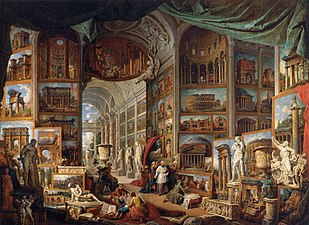 Gallery of Views of Ancient Rome (1758), oil on canvas, 203 x 300 cm., Louvre
Gallery of Views of Ancient Rome (1758), oil on canvas, 203 x 300 cm., Louvre
Drawings
-
 Man Shading His Face with a Tricorne (no date), brown wash, over graphite, 21.6 x 10.6cm., Metropolitan Museum of Art
Man Shading His Face with a Tricorne (no date), brown wash, over graphite, 21.6 x 10.6cm., Metropolitan Museum of Art
-
 Saint Paul Preaching in Athens, 1734, National Gallery of Art
Saint Paul Preaching in Athens, 1734, National Gallery of Art
-
 The Lottery in Piazza di Montecitorio (1743-44), Pen, ink, watercolor, graphite, 34 x 54.5cm., Metropolitan Museum of Art
The Lottery in Piazza di Montecitorio (1743-44), Pen, ink, watercolor, graphite, 34 x 54.5cm., Metropolitan Museum of Art
-
 Staircase of the Trinity of Mont (ca. 1756-58), Pen, ink, wash, watercolor, and graphite, 34.8 x 29.3 cm., Metropolitan Museum of Art
Staircase of the Trinity of Mont (ca. 1756-58), Pen, ink, wash, watercolor, and graphite, 34.8 x 29.3 cm., Metropolitan Museum of Art
-
 Arch of Titus (no date), pen, ink and wash, 18.7 x 12.2 cm., National Gallery of Art
Arch of Titus (no date), pen, ink and wash, 18.7 x 12.2 cm., National Gallery of Art
-
 Ruins of a Basilica or Mausoleum (no date),Pen, ink, and wash, 31 x 20.6cm., Metropolitan Museum of Art
Ruins of a Basilica or Mausoleum (no date),Pen, ink, and wash, 31 x 20.6cm., Metropolitan Museum of Art
References
- ^ Anna Maria Ferrari. "Panini, Giovanni Paolo." Grove Art Online. Oxford Art Online. 27 March 2010.
- Bryan, Michael; Williamson, George Charles (1903–1905). Bryan's dictionary of painters and engravers. New York Public Library. New York : Macmillan.
- "Pannini, Giovanni Paolo nell'Enciclopedia Treccani". www.treccani.it (in Italian). Retrieved 2023-04-25.
Translated: Of his sons, Giuseppe (Rome 1720 - 1812), was architect and archaeologist, Francesco (Rome 1725 circa - there after 1794), collaborator of his father, was the author of views for engravings.
- "PANNINI, Gian paolo in "Enciclopedia Italiana"". www.treccani.it (in Italian). Retrieved 2023-04-25.
Translated: In 1724 he had married Miss Gossert, sister-in-law of Wengkels, director of the French Academy, with whom he had two sons: Giuseppe the architect and Francesco the painter, who followed in his father's footsteps and manners.
- ^ "Panini, Giovanni Paolo - Colección - Museo Nacional del Prado". www.museodelprado.es. Retrieved 28 December 2020.
- "Louvre Museum Official Website". cartelen.louvre.fr. Retrieved 2021-02-19.
- ^ "Web Gallery of Art, searchable fine arts image database". www.wga.hu. Retrieved 2021-02-19.
- "St. Peter's Square, Rome". emuseum.toledomuseum.org. Retrieved 2021-02-19.
- "Exchange: Landscape with Classical Ruins". exchange.umma.umich.edu. Retrieved 2021-02-19.
- "Brooklyn Museum". www.brooklynmuseum.org. Retrieved 2021-02-19.
- "Interior of St. Peter's, Rome". Saint Louis Art Museum. Retrieved 2021-02-19.
- "View of the Colosseum". www.dia.org. Retrieved 2021-02-19.
- "Picture Gallery with Views of Modern Rome". collections.mfa.org. Retrieved 2021-02-19.
- "Three Figure Studies (Getty Museum)". The J. Paul Getty in Los Angeles. Retrieved 2021-02-19.
- "Giovanni Paolo Panini | Ancient Rome". www.metmuseum.org. Retrieved 2021-02-19.
- "Giovanni Paolo Panini – Artists/Makers – The Nelson-Atkins Museum of Art". art.nelson-atkins.org. Retrieved 2021-02-19.
- "The Colosseum and the Arch of Constantine (Primary Title) - (65.27)". Virginia Museum of Fine Arts |. Retrieved 2021-02-19.
- "Giovanni Paolo Panini |". The Walters Art Museum. Retrieved 2021-02-19.
- Harvard. "From the Harvard Art Museums' collections Adoration of the Magi". harvardartmuseums.org. Retrieved 2021-02-19.
- "Philadelphia Museum of Art - Collections Object : Roman Monuments". www.philamuseum.org. Retrieved 2021-02-19.
- "Roman Capriccio: The Pantheon and Other Monuments". Indianapolis Museum of Art Online Collection. Retrieved 2021-02-19.
Further reading
- Arisi, Ferdinando (1986). Gian Paolo Panini e i fasti della Roma del '700 [Gian Paolo Panini and events in 18th c. Rome.] (in Italian). U. Bozzi. ISBN 88-7003-016-4.
- Arisi, Ferdinando,Giovanni Paolo Panini 1691-1765, Milano, 1993.
- Horak, Marco, Ritornato a Piacenza il dipinto di Panini passato all'asta lo scorso anno a Londra: si tratta dell' "opera prima", pendant di quello esposto alla Glauco Lombardi di Parma, in "Strenna Piacentina 2013", Piacenza, 2013.
- Horak, Marco, Quell'opera prima di Panini gemella del dipinto esposto al Lombardi di Parma, in "L'Urtiga - Quaderni di cultura Piacentina", Piacenza, n. 4, 2013.
- Horak, Marco, L'opera prima del Panini in una collezione privata, in "Panorama Musei", anno XVIII, n.3, dicembre 2013
- Horak, Marco, G.P. Panini al Fine Art Museum di San Francisco, in "Panorama Musei", anno XXI, n. 2, settembre 2016
- Horak, Marco, Giovanni Ghisolfi tra Salvator Rosa e Giovanni Paolo Panini, Piacenza, 2020
- Bryan, Michael (1904). Williamson, George Charles (ed.). Bryan's Dictionary of Painters and Engravers. Vol. IV: N-R (new revised and enlarged ed.). London: George Bell and Sons. p. 62; Entry on Giovanni Paulo Pannini & Giuseppe Pannini
{{cite book}}: CS1 maint: postscript (link)
External links
- 68 artworks by or after Giovanni Paolo Panini at the Art UK site
 Media related to Giovanni Paolo Pannini at Wikimedia Commons
Media related to Giovanni Paolo Pannini at Wikimedia Commons- Art and the empire city: New York, 1825-1861, an exhibition catalog from The Metropolitan Museum of Art (fully available online as PDF), which contains material on Panini (see index)
- Europe in the age of enlightenment and revolution, a catalog from The Metropolitan Museum of Art Libraries (fully available online as PDF), which contains material on Panini (see index)
- Capriccio of Roman Ruins with Figures, from the Permanent Collection of the Utah Museum of Fine Arts
- Panini at Waddesdon Manor
| Giovanni Paolo Panini | |
|---|---|
| Paintings | |
| Painting series |
|
| Related |
|